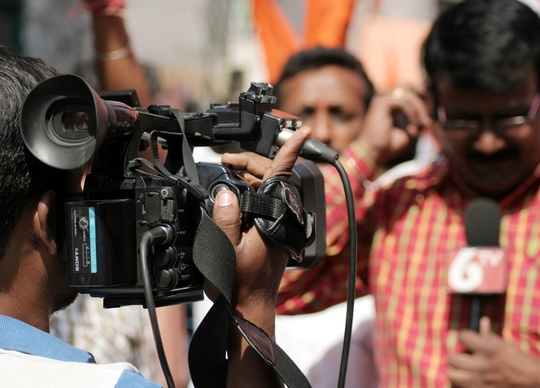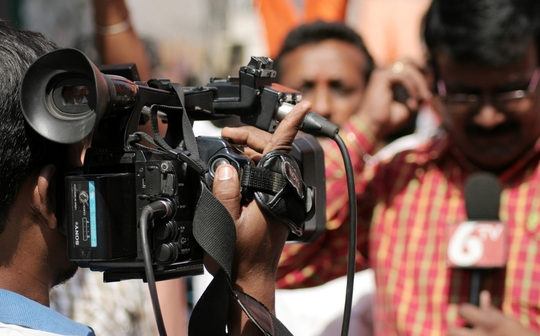
By Sarosh Bana.
In yet another jolt to the Right to Freedom of Speech and Expression that Article 19 of India’s Constitution guarantees, the Narendra Modi regime has introduced a new set of rules, Central Media Accreditation Guidelines 2022, which further warn journalists to steer clear of government criticism.
In a manner unprecedented in independent India, the country’s mainstream broadcast and telecast media have been rendered so supine that Indian readers often look to social media, the odd online news service, and even foreign publications for unbiased news.
The new “guidelines” empower the authorities to revoke the government accreditation of journalists if they act in a manner “prejudicial to the sovereignty and integrity of India, the security of the state, friendly relations with foreign states, public order, decency or morality, or in relation to contempt of court, defamation or incitement of an offence”.
The Press Information Bureau released the new guidelines recently. While earlier, a committee of the Bureau would scrutinise applications for accreditation in order to approve or reject them, another committee will now rule on rescinding the accreditations. As this newly-formed committee will be staffed by government officials, it will essentially be the government ruling on its own grievances against any accredited journalist. Such a framework ensures that the government view is upheld.
Newspersons whose accreditation is annulled are denied access to government officials and offices, as also to ministerial press conferences and official programmes and visits. This would discredit them professionally as also mar their scope for news-gathering.
The national media have been severely repressed by the Hindu right-wing Narendra Modi government, which has imposed a robust news management regime since coming to power in 2014. Dissenting news outlets and their managements have been raided, prosecuted under serious charges, or pressured through withdrawal of government advertising, while individual journalists have been targeted with extreme measures.
Worse has been the government’s penchant of deterring criticism by charging critical media persons under draconian laws. It is hence feared that any news items deemed inconvenient may selectively be interpreted as “prejudicial to the sovereignty and integrity of India, the security of the state, friendly relations with foreign states, public order, decency or morality, or in relation to contempt of court, defamation or incitement of an offence”.
Similar action has been initiated on even mere suspicion of “negative reporting”. In one such instance, south Indian journalist Siddique Kappan was arrested as he headed for a town called Hathras to report on the alleged gang-rape there, of a low caste Dalit woman – who died later in hospital – in October 2020. The authorities barred the victim’s family from meeting any outsiders, particularly reporters, in an effort to suppress publicity on the horrifying incident.
The police filed a 5,000-page charge sheet against Kappan under the repressive anti-terror law, Unlawful Activities (Prevention) Act (UAPA).
The government has also been liberal in applying the controversial colonial-era law on sedition, or treason, registering as many as 399 such cases across the country from 2014 to 2020. That this harsh law, which had been used by the British rulers to counter the freedom movement, was applied on flimsy grounds is evinced from the fact that only eight of the cases have resulted in convictions.
Last June, India’s Supreme Court quashed a case of sedition against veteran journalist Vinod Dua, who has since died, but who had been charged for making statements against the Modi government’s handling of the Covid-19 pandemic, particularly the abruptly-announced nationwide lockdown that had devastated millions of migrant workers who were stranded miles from home without food or shelter.
The complaint against Dua was by a ruling Bharatiya Janata Party (BJP) leader who accused the journalist of inciting communal violence and disrupting harmony. The apex court, however, significantly ruled that “dissent is not sedition”. A two-judge bench of the court observed that no journalist could be arrested on sedition charges merely for harshly criticising the government or the establishment if he or she did not incite violence against the government or hatred between communities.
Indeed, Article 19 of the Indian Constitution provides the Right to Freedom of Speech and Expression, which includes freedom of the press. However, India retained its low ranking last year of 142 out of 180 countries, as in the year before, on the Global Press Freedom Index. French NGO, Reporters Without Borders (RSF), which prepares the annual Index, said, “India is one of the world’s most dangerous countries for journalists trying to do their job properly.” India had ranked 122nd on the list in 2010, but has declined markedly under BJP rule.
New York-based Committee to Protect Journalists (CPJ) reported last December that at least 24 journalists were killed for their coverage and 18 others died in “circumstances too murky to determine whether they were specific targets”. While it found China to be the “worst jailer of journalists” for the third year in a row, followed by Myanmar which saw a media crackdown after the military coup in February 2021, it cited India as having “the highest number of journalists – four – confirmed to have been murdered in retaliation for their work”.
CPJ’s database listed Avinash Jha, Chennakeshavalu, Manish Kumar Singh, and Sulabh Srivastava as being “murdered”, and Raman Kashyap as being killed while on a “dangerous assignment”.
Again, last December, South African non-profit organisation Civicus released a report, titled “Civicus People Power Under Attack 2021”, which listed India as a nation with “repressed” democratic values. The survey mentioned: “National security and anti-terror laws such as the repressive UAPA have been systematically abused in India by the government of Prime Minister Narendra Modi…”.






